All modern goldfish are selective forms that do not occur in nature. Some of the breeds are closer to their natural form (goldfish) and therefore hardier, others have been so modified by a man that they require more careful care
Goldfish aquarium
Goldfish have been kept by people as pets for more than one millennium. But even for such a long period of time, they have not lost their popularity at all.
All goldfish are large in body size. Some representatives of long-bodied breeds can reach a length of 20-30 cm. Therefore, wishing to have goldfish, it is imperative to clarify the maximum size of adults in order to correctly select the volume of the aquarium. It is also worth remembering that goldfish prefer to keep in small flocks, although the solitary existence does not scare them.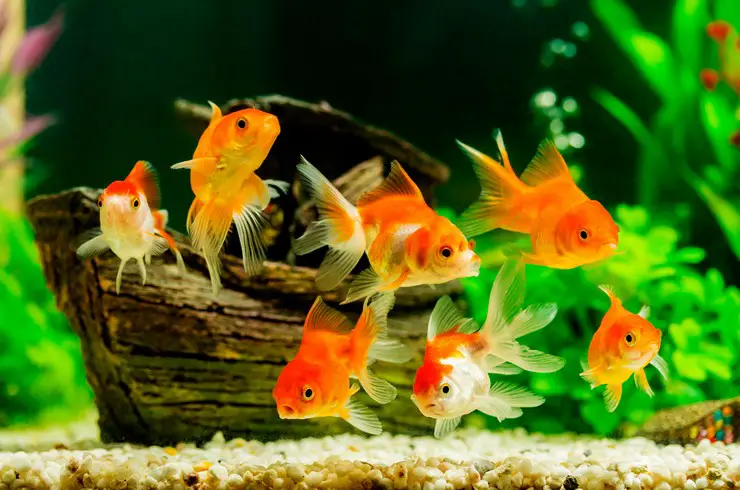
Ideally, one goldfish should have at least 50 liters of water. A classic rectangular aquarium with a height of 45-50 cm will be the best choice. If you plan to keep long-bodied breeds of gold (comets, shubunkins), then stop at an aquarium that is elongated in length so that these active fish have a place to swim.
Natural stones and ceramic grottoes are most often used as decorations. In this case, care must be taken that they do not have sharp edges, about which the fish can injure their body and fins.
Goldfish have gained fame as aquarium “dirty” because of their voracity and a large amount of waste released into the aquarium. Therefore, be sure to take care of a powerful filter that will effectively fight the pollution of the aquarium. It is recommended to use external filters. A compressor is also required because these fish need oxygen-rich water, and besides, in aquariums with goldfish, live plants that can produce it are practically not used. But there is no need for a thermostat because goldfish prefer cool water, the temperature of which does not exceed 23 ° C.
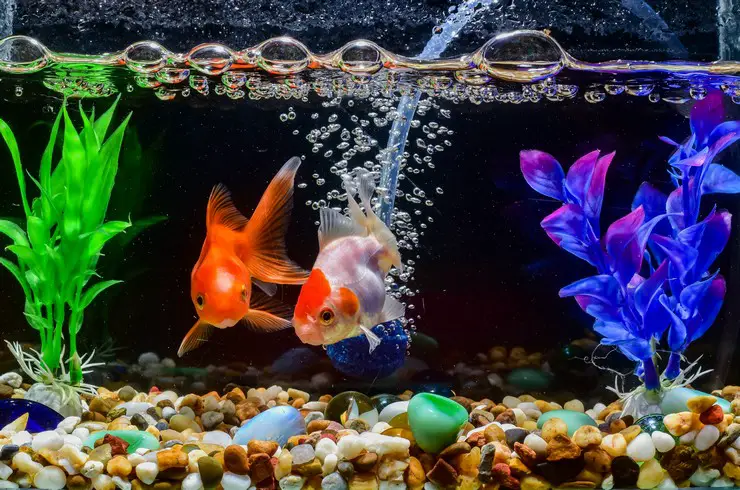
Water parameters
Goldfish, unlike most other aquarium inhabitants, are cold-water fish. This means that a comfortable temperature for their maintenance will be in the range of 18-23 ° C. In the summer, a significant part of goldfish can live quietly in decorative ponds. As for the rest of the water parameters, the fish treat them calmly, if there are no sharp nets. Goldfish live in soft and hard water, in slightly acidic and slightly alkaline. Such endurance is a gift from wild ancestors.
Optimum water parameters for the content:
- Temperature: 18-23 ° С;
- Acidity (pH): 6.0 – 8.0;
- Hardness: 8 – 25.
To maintain high water quality and prevent the accumulation of toxic metabolic waste products, a 20% water change is required once a week in a goldfish tank. If tap water is used for changes, add Tetra AquaSafe conditioner to the bucket before pouring it into the aquarium. It will instantly bind compounds toxic to fish (chlorine, heavy metals) and enrich the water with essential vitamins. The dosage of the product is 5 ml per 10 liters of water to be replaced. Many aquarists believe that it will be enough just to defend the water, but this is a misconception because, during settling, only chlorine is removed from the water, other dangerous compounds do not disappear anywhere. Not to mention the fact that if you need to make a change in very large aquariums, you will have to defend a whole barrel of water, and this is very inconvenient.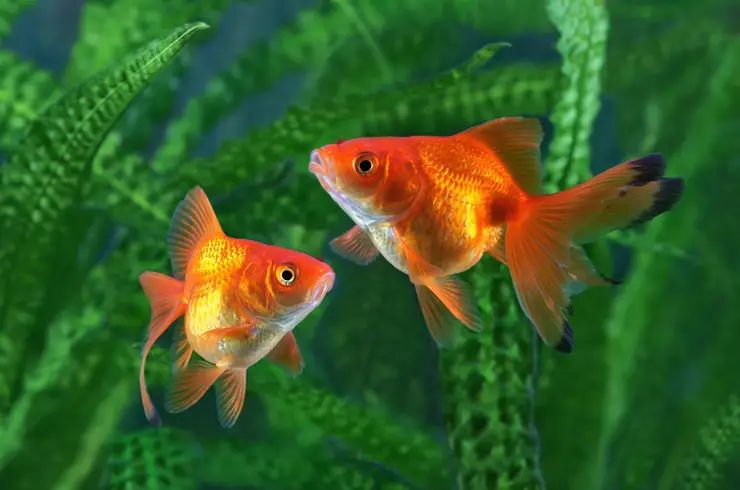
If necessary (for example, for the treatment of certain diseases), a little salt (5-7 g / l) can be added to the gold aquarium. The fish will tolerate this without problems.
Shine
Goldfish do not require any special lighting. Modern aquarium lamps with a color temperature of 6000-6500 K perfectly emphasize the bright color of the fish and the naturalness of the environment. Given that aquariums with goldfish rarely contain live plants, the accumulation of nitrates and phosphates occurs very quickly, and if you add to this excess light, then an outbreak of algae is inevitable.
Priming
Choosing soil for goldfish, it is important to know that these “crucians” simply love to dig at the bottom and constantly sort through the soil in search of food. Therefore, it must be of such a fraction that the pebbles do not fit entirely into the fish’s mouth, otherwise, the pet may accidentally swallow it. It is best to use large, rounded pebbles that will not damage the mouth of your goldfish.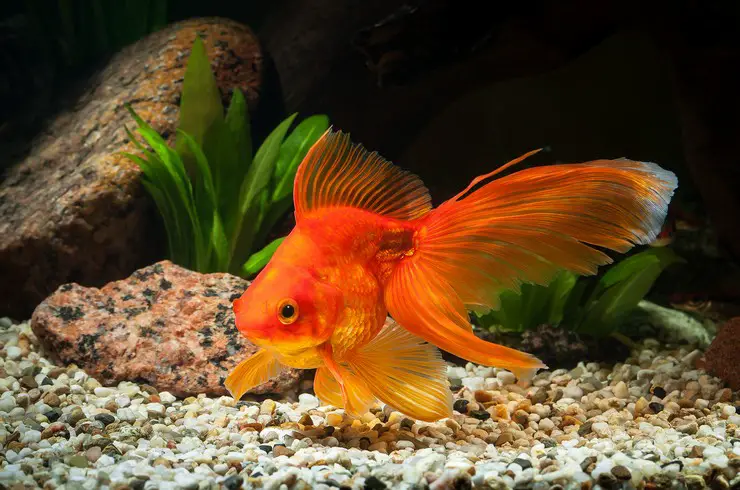
Plants
Artificial plants are most commonly found in goldfish aquariums. And the choice falls on them for a reason. The diet of goldfish includes both animal and plant foods. Moreover, the percentage of the latter is quite large: fiber promotes proper digestion. Therefore, goldfish are not averse to biting the delicate leaves of most aquatic plants. Among the species that resist the onslaught of the golden ones, one can distinguish Anubias, Echinodorus, Elodea, Giant Vallisneria, Cryptocorynes.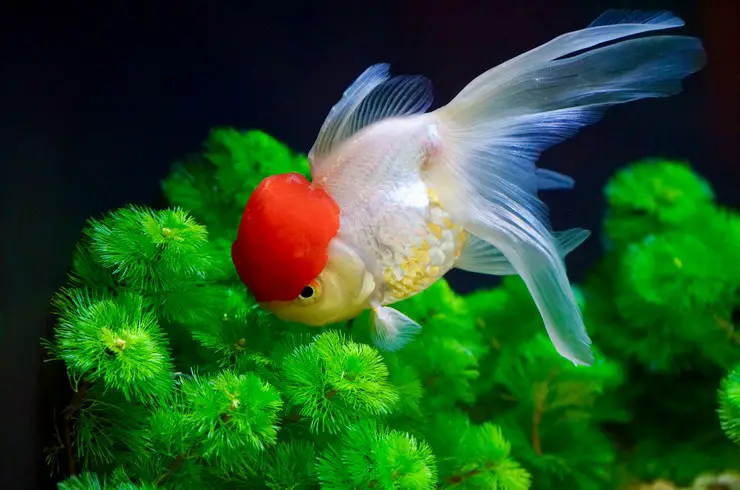
The problem of compatibility of goldfish with plants is also associated with their habit of constantly stirring up the soil, therefore, when planting plants, their roots must be isolated from the fish.
Feeding goldfish
Feeding goldfish at home should be varied, but the use of live and frozen food is not recommended. Constant high-protein food leads to gastrointestinal diseases. In no case should you use vegetable porridge (oatmeal, wheat, rice), which will quickly lead to water pollution?
It is best to stop at high-quality dry food because they are absolutely safe, completely balanced, and cannot become a source of infection. It is important to remember that the plant component should make up a significant portion of the goldfish diet.
Tetra has developed a range of high quality, specialty food for goldfish with the Clean & Clear Water formula: the components of the food are well-absorbed, which reduces the amount of fish excrement and allows the aquarium water to stay cleaner for longer.
- Tetra Goldfish (Granules) is food in the form of flakes or floating granules, universal for all types of goldfish. An optimally selected composition improves their health and vitality.
- Tetra Goldfish Pro is a food made with gentle technology that allows you to preserve more nutrients and vitamins. Chips shaped with nutrients in the rim and krill in the middle to enhance natural coloration and maintain muscle tone.
- Tetra Goldfish Gold Japan is a premium pellet feed for all breeding goldfish (oranda, telescopes, riukins, and others). Mini pellets quickly soften in water and gradually sink to the bottom, which is consistent with the habit of Japanese goldfish to seek food at the bottom. Natural carotenoids enhance the color of fish. The food is rich in plant proteins for optimal digestion.
It is necessary to feed the goldfish very carefully. They tend to overeat, which can manifest as swimming on their side for a while. It is better to feed the fish several times a day with a small pinch of food.
